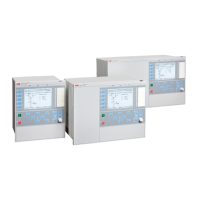13.5.6.1 Testing the carrier send and trip signals
Procedure
1.
Set the operation of all distance zones, which are supposed to be blocked by
the operation of ZMRPSB, to Off.
2. Configure the STPSD functional inputs to the TRIP output of the
underreaching power-swing zone, if the underreaching communication
scheme is used.
3. Start instantaneously any kind of fault within the underreaching power-swing
zone and check, that:
• The CS signal appears after the time delay, which is equal to the sum of
set time delays for the underreaching zone tnPP or tnPE (dependent on
the type of fault) and for the carrier send security timer tCS. Also add
the usual operate time for the underreaching zone (approximately 30ms).
• The TRIP signal appears after the time delay, which is equal to the sum
of set time delays for the underreaching zone tnPP or tnPE (dependent
on the type of fault) and for the trip security timer tTrip. Also add the
usual operate time for the underreaching zone (approximately 30ms).
4. Simulate the receiving of the carrier signal so that the functional input signal
CR becomes a logical one.
5. Configure the STPSD input to connect to the output START of the carrier
accelerating zone (Power-swing overreaching zone).
6. Initiate any kind of fault within the carrier accelerating zone and check that
the TRIP signal appears after the time, which is equal to the time delay set on
the trip timer tTrip.
Also consider the (average) operate time of the carrier acceleration zone
(approximately 30ms).
13.5.6.2 Testing the influence of the residual overcurrent protection
Additionally connect the IED according to the test instructions for the four step
residual overcurrent protection function EF4PTOC, if the Power swing logic
(ZMRPSL) is configured in a way that is controlled by this protection.
Procedure
1. Initiate a single phase-to-earth fault within both power-swing zones.
Make sure that none of CS and TRIP output signals appear after the time
delays tCS and tTrip.
BLKZMUR must appear together with the fault and must remain active until
the fault has been switched off plus the time delay, as set on the tBlkTr timer.
2. Initiate a phase-to-phase fault within the operating area of both power-swing
zones.
Section 13 1MRK 504 088-UEN C
Verifying settings by secondary injection
132
Installation and commissioning manual

